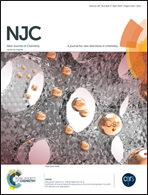Tuning the optical and electrochemical properties of core-substituted naphthalenediimides with styryl imide substituent†
Abstract
The effect of styryl imide substitution on optical and electrochemical properties of core-substituted naphthalenediimides was examined by synthesizing a series of naphthalenediimide molecules. 2-Ethylhexylamino and 5-(2-ethylhexyl)thiophene groups were used as core substituents. The optical and electrochemical properties of styryl imide substituted compounds were compared with other imide substitutions including hydrogen, 2-ethylhexyl, and 4-thienylphenyl. Generally, the imide substituents had little effect on the optical properties, except when the combination of alkylamino core and styryl imide substituents was used. In this latter case, we observed a 104 nm red-shift of the absorption onset upon film formation, resulting in an unusually broad visible absorption (500–800 nm) for these types of molecules. This is explained by the planarity of the molecule and the formation of intermolecular aromatic donor–acceptor type interactions. These results show that imide substituents play a role in tuning opto-electronic properties of NDI molecules, and that NDI molecules with styryl imide substituents merit further evaluation for opto-electronic applications.



 Please wait while we load your content...
Please wait while we load your content...